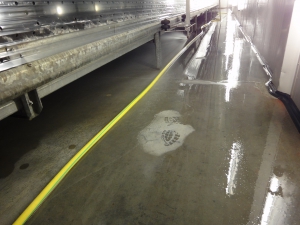Floor humidity and the effects
Floor humidity
If you want to maintain a natural climate in the growing room during the recovery period until about five days after ventilation you should water the floor and walls of the growing room. Do this at intervals of between one and six hours. You will notice the result as a shock effect in the graph displaying the RH and growing room temperature. I will explain what is actually happening and how to avoid a shock effect.
The effects of floor humidity
If you stand in the growing room while the watering system is wetting the floors and walls you will see several things happening. The watering system contains nozzles which moisten the floors and walls with water droplets and it also creates tiny, airborne droplets of water. If you shine a torch you will see the little water droplets floating in the air. Eventually the droplets fall onto the beds and the sensors of the climate computer. This has two disadvantages:
1. Climate disruption
The water droplets which fall on the sensors are cold. They disrupt the climate, which causes a response from the computer. The effect is minimal but your aim is to keep the climate as constant as possible. This uses the least energy.
2. Abnormalities
The water droplets fall on the beds where the mycelium is recovering. These water droplets disrupt pinning, resulting in cluster-shaped abnormalities which develop before the first flush.
How can you prevent this?
Make sure that there is sufficient water pressure (see photo) while the floors and walls are being wetted. In this way you prevent the droplets from floating in the air. In addition, make sure that the whole floor is wet. This approach means that the floors dry out less quickly, ensuring that the climate in the growing room is more uniform and favourable for growth.
Mark den Ouden
Next courses:
Live training Mushroom Signals Essentials: 12 – 16 October 2020
The e-learning course offers the theorical knowledge of the Mushroom Signals book that is necessary for the live training sessions. During live training, all participants have the same basic knowledge, so there is plenty of time to deal with individual questions. This is not only valuable for the participant but sharing knowledge between the trainer and the other participants makes the theory more relevant. The everyday practice at the composting facility and the mushroom farm of the participants will also be discussed.
Other courses in 2020: 30 November – 4 December 2020.
Always available:
E-course Mushroom Signals Essentials
More info about the course see www.mushroomoffice.com






















